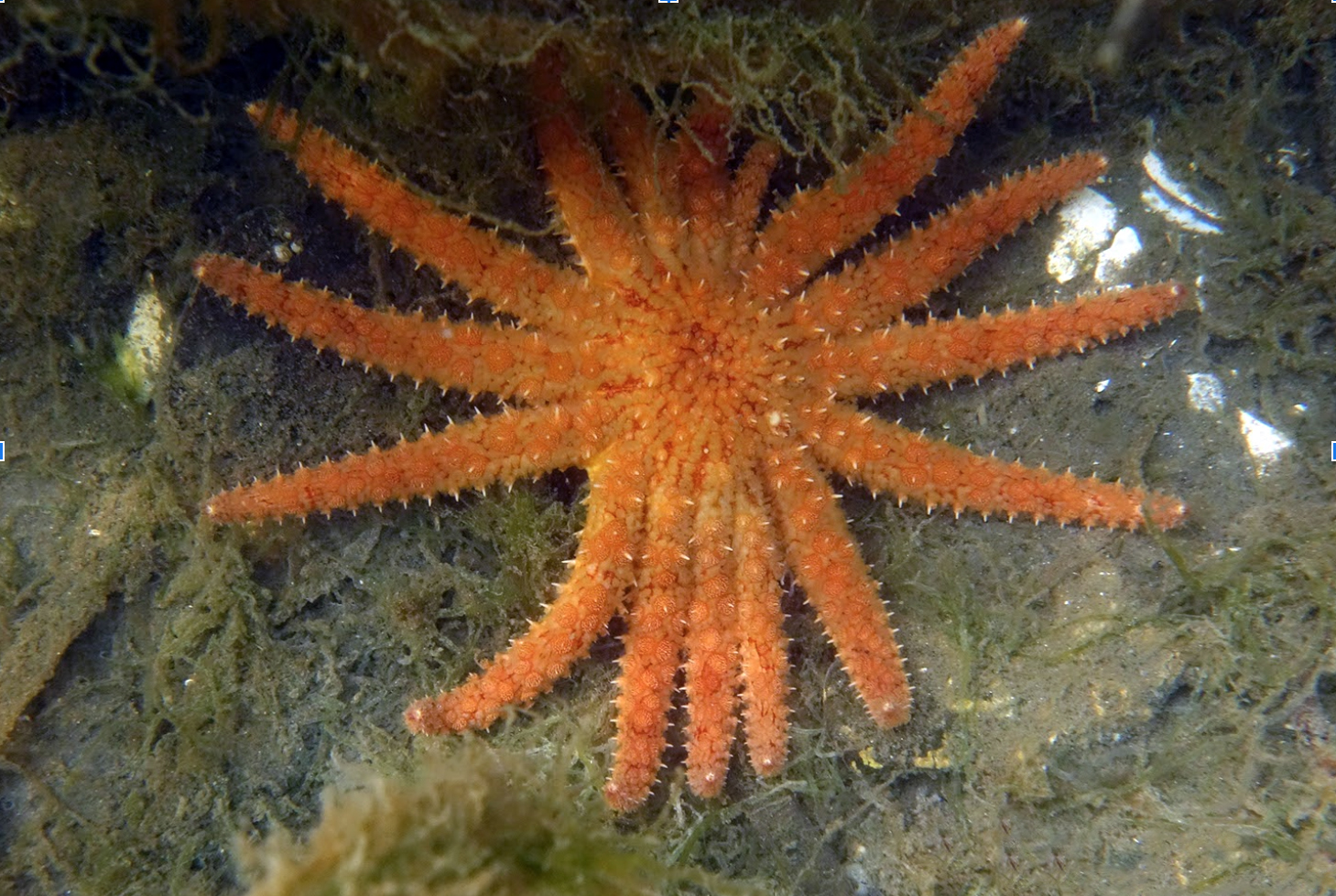Antranig Basman, Charles J. Gibbs, Donna M. Gibbs, Andy Lamb, Philip Lambert, Andrew Simon
May 23rd, 2023
Galiano Island’s echinoderm diversity
‘Echinodermata’ is rooted in the Ancient Greek ἐχῖνος (echīnos), meaning “hedgehog”, and δέρμα (derma), “skin”.
Echinoderms are a phylum of marine invertebrates characterised by tough, spiny skin and radial symmetry, containing over 7,000 recognised species worldwide. The phylum comprises five extant classes, all of which are represented locally. These include Asteroidea (sea stars), Crinoidea (crinoids), Echinoidea (sea urchins and sand dollars), Holothuroidea (sea cucumbers) and Ophiuroidea (brittle stars). In total, 111 echinoderm species are known to British Columbia Of these, 41 species have been reported for Galiano Island, through the combined efforts of more than 10 individuals.

Sunflower sea star (Pycnopodia helianthoides) – Photograph by Karolle Wall
Echinoderms, especially sea stars, are an ecologically important component of the marine fauna of the Northeast Pacific. The term “keystone species” was first coined by Paine (1966) to describe the dominant influence of the predatory ochre sea star (Pisaster ochraceus) over the structure and composition of intertidal communities. Since 2013, sea stars, such as the ochre sea star and the sunflower sea star Pycnopodia helianthoides, have undergone severe declines in the region due to sea star wasting syndrome and their populations have not yet recovered. Research indicates that sea star wasting syndrome may be the consequence of elevated microbial activities induced by high organic matter concentrations, which causes depleted oxygen conditions at the animal-water interface, such that sea stars cannot meet the respiratory oxygen demand of tissues. This phenomenon is likely exacerbated under warmer ocean conditions and anthropogenic nutrient pollution.
Community science contributions
Since the Biodiversity Galiano project began in 2016, our community has documented 27 echinoderm species in the waters around Galiano Island, confirming 62 percent of the historical records and adding no new species to the list. Of the 40 historically reported taxa, 15 species remain unconfirmed, having gone unreported in the last twenty years.
Under-represented echinoderms in the Galiano Island record include the holothuroids and ophiuroids. This gap is likely due to sampling bias, as many of these taxa are found at deeper depths than have been sampled locally or otherwise tend to be buried beneath rock and sediment. Gaps otherwise relate to limits in taxonomic knowledge. For example, the genus Henricia is highly variable and in need of clarification. Genetic studies are underway to sort out many suspected new species of Henricia between Alaska and California. Leptasterias hexactis also belongs to a species complex (Leptasterias aequalis species complex) requiring further study.

Henricia sp. – Photograph by Isabelle Côte
Echinoderms with Indigenous cultural significance
Echinoderms are one of many phyla that have cultural significance to Hul’qumi’num speaking peoples. Generally, echinoderms are regarded as important food sources for delicacy and cultural practice. Many of echinoderm species have experienced declines in populations in recent years, making their havesting and consumption increasingly difficult.
Giant Red Sea Cucumber, known in Hul’qumi’num as Thikwt Thikwt is regarded as a delicacy by many and is typically cleaned and eaten whole in stews or stocks. Thikwt can be harvested with a 3-pronged spear, rake, or by collection via diving.
Sea Urchins (Red)Sea Urchins (Purple, known in Hul’qumi’num as Xihwu, Xihwu Xihwu is also regarded as a delicacy and can similary be harvested by a 3-pronged spear or rake like Thikwt. Because Xihwu are thin shelled, they can easily be eaten or used for bait. Purple urchins in particular are a rare delicacy known for their sweet taste.
Green Sea Urchin, known in Hul’qumi’num as Skw’itth’i’ Skw’itth’i’ were once common and plentiful on both rocky shores and kelp beds, however, they are now a rare delicacy. Today, to harvest skw’itth’i’, journeying to areas with fast moving waters is required.
Top community contributions to our knowledge of the island echinoderm diversity
Here, you can browse photos of echinoderm species commonly documented around Galiano Island, as well as recent observations, most favourited observations, and top observers, based on iNaturalist data. Please help contribute to the growing record of the island echinoderm diversity by submitting your observations to the Biodiversity Galiano iNaturalist project.